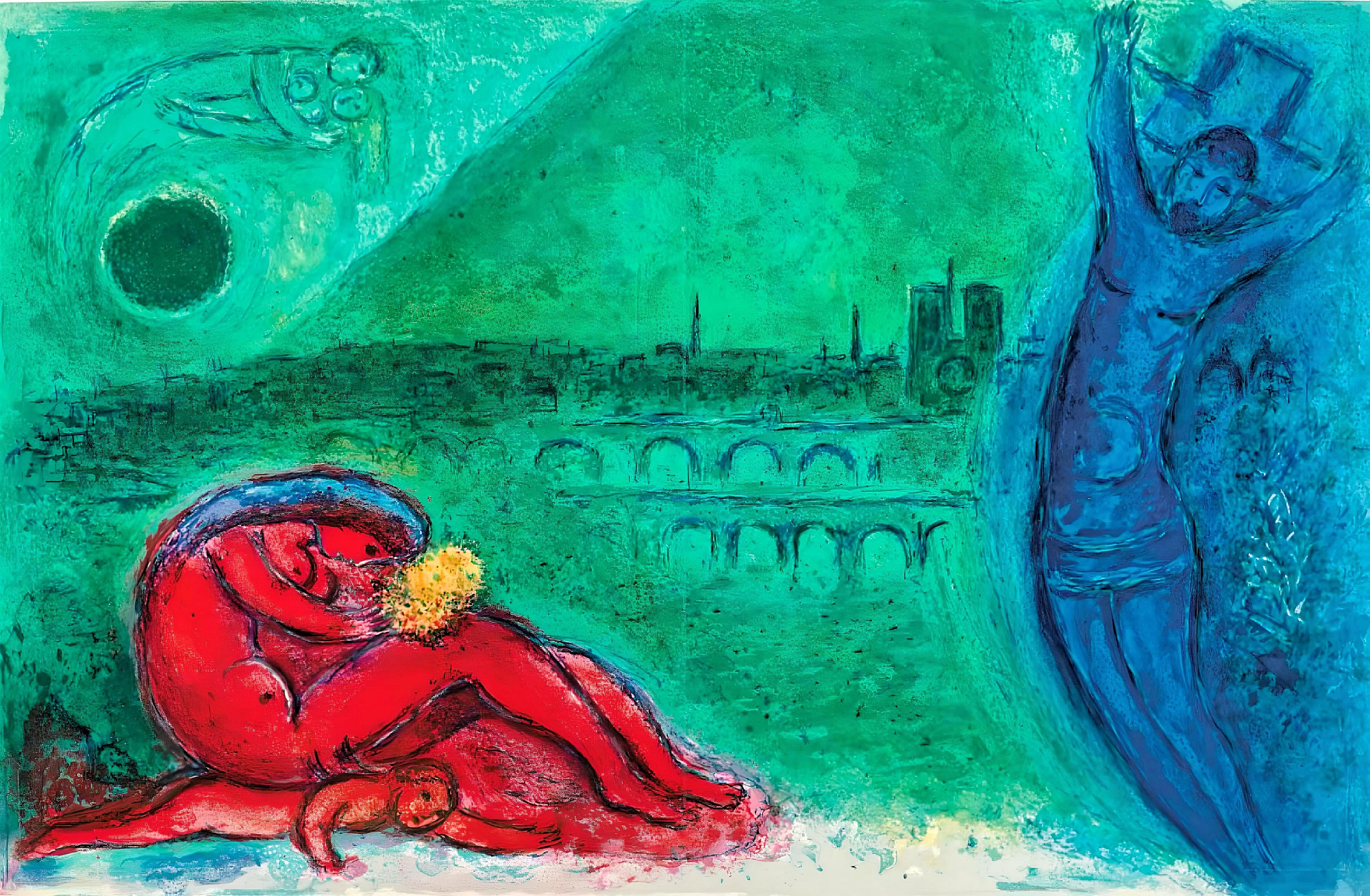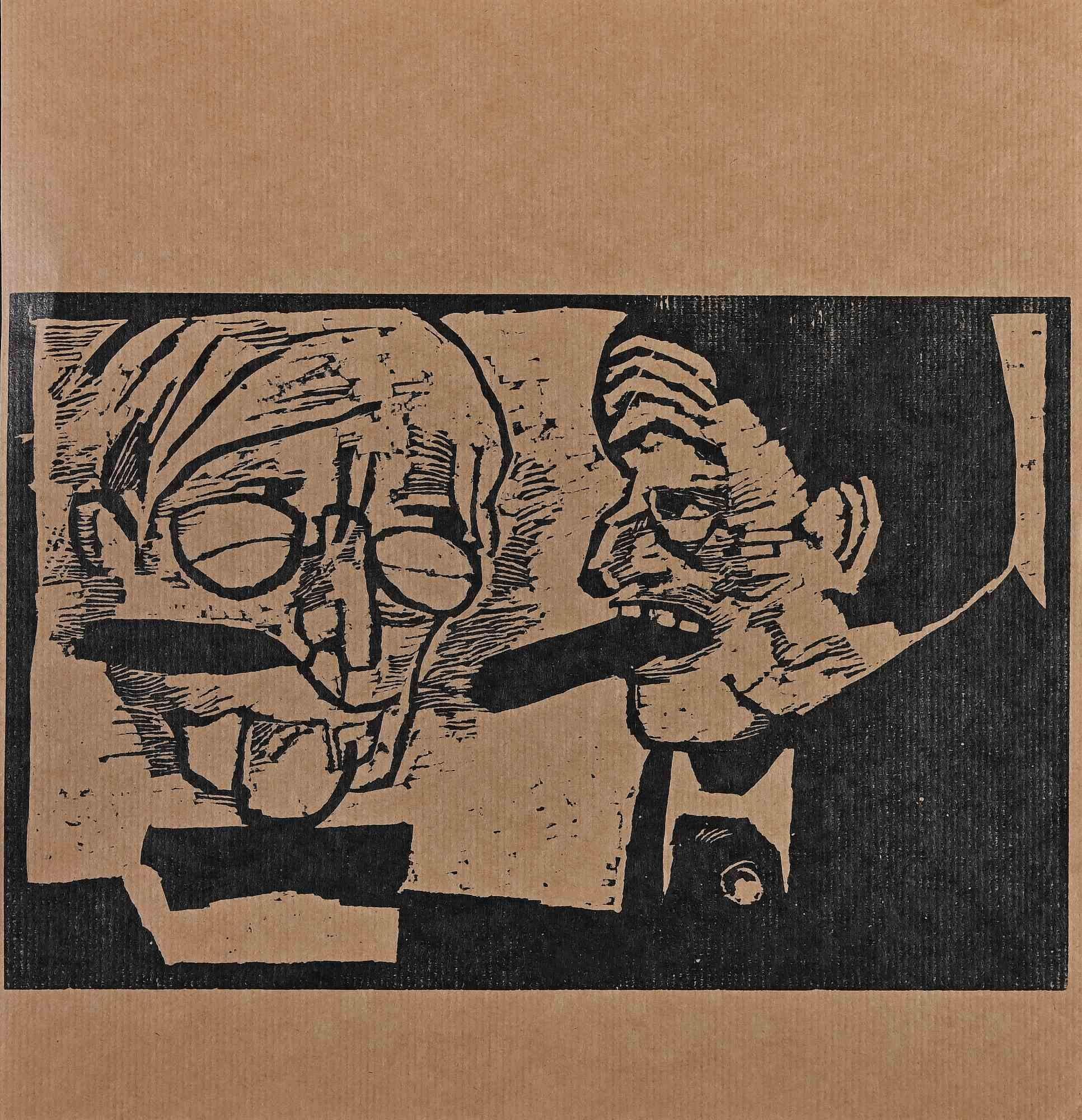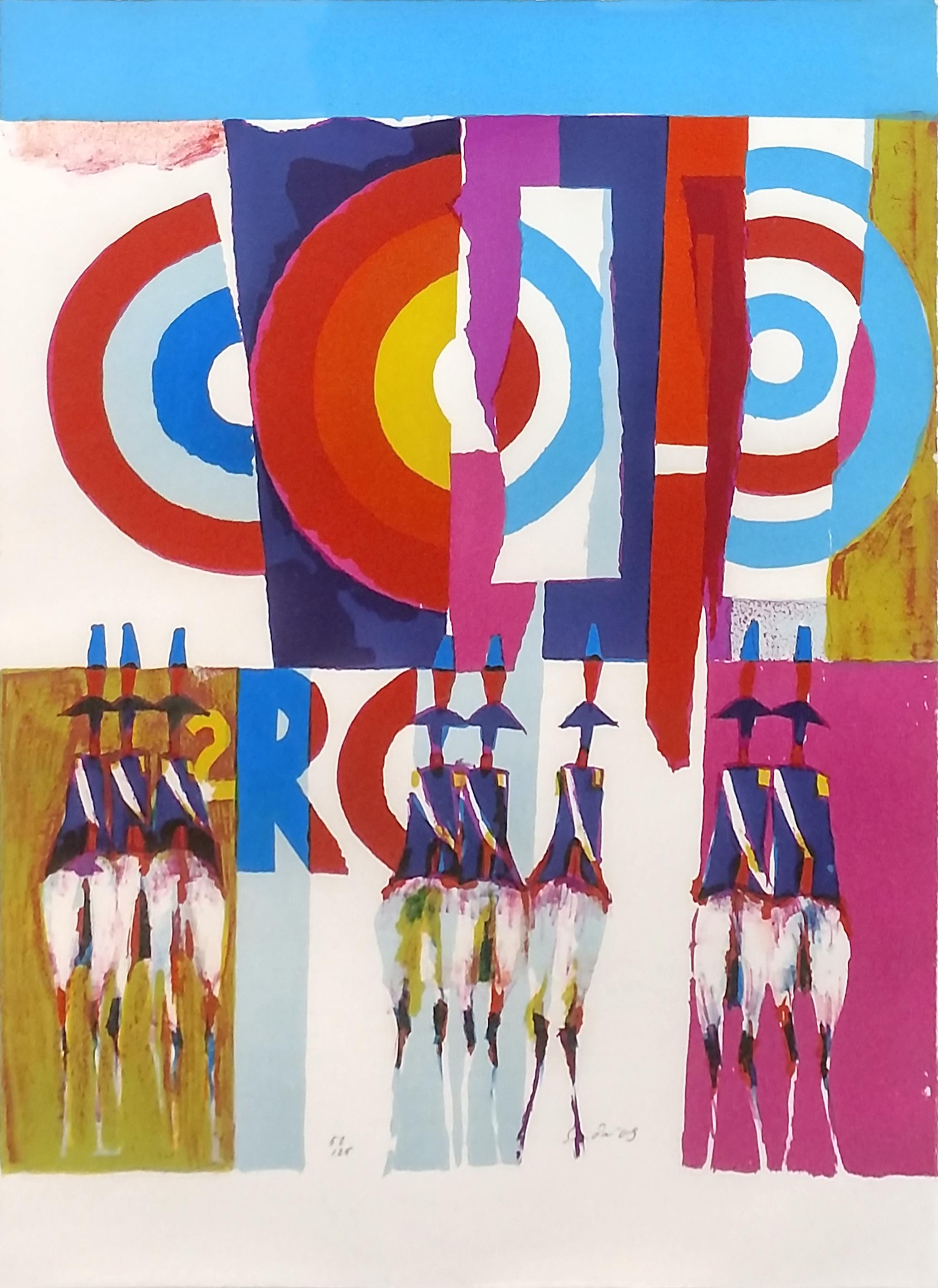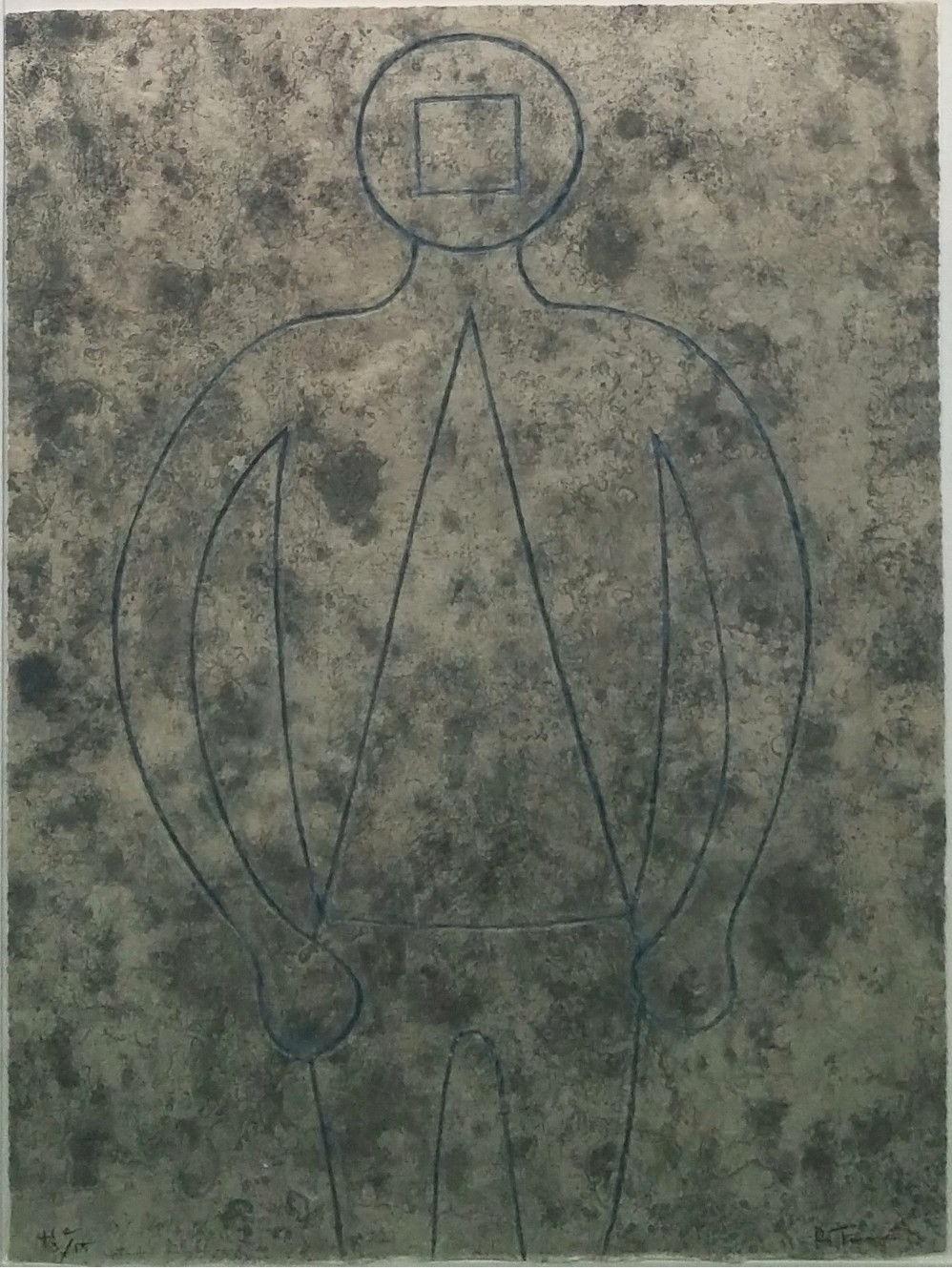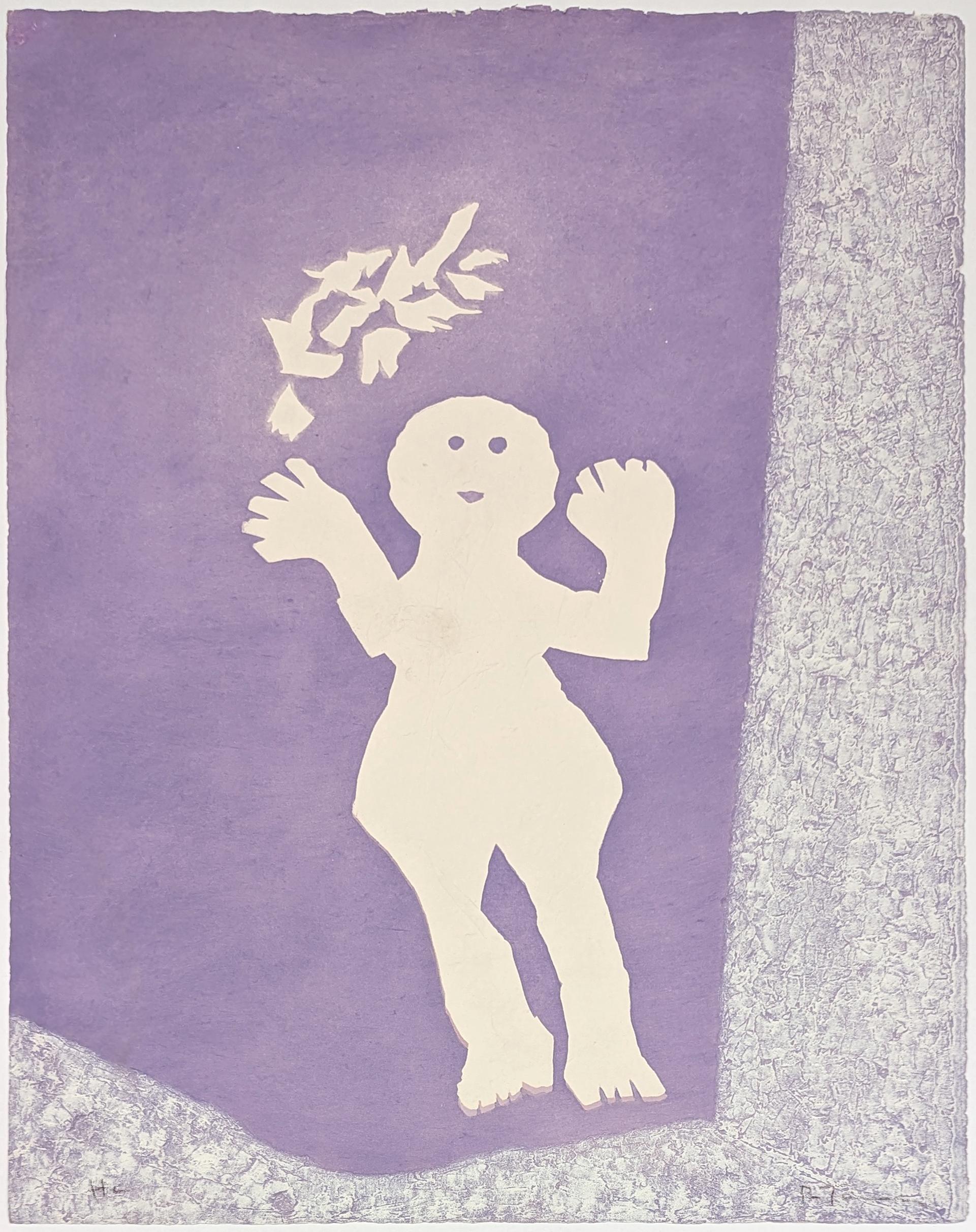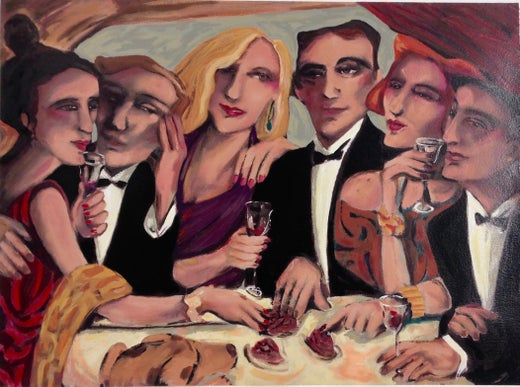Items Similar to "Life Is Just A Shell Game" contemporary expressionist Serigraph
Want more images or videos?
Request additional images or videos from the seller
1 of 6
Sandra Jones Campbell"Life Is Just A Shell Game" contemporary expressionist Serigraph2005
2005
About the Item
"Life Is Just A Shell Game" is from Sandra Jones Campbell's series inspired by her unique social observations. It features her unique blend of modernism and expressionistic style, along with strong colors; bold reds, golds, black, and tans. It is a 90 color hand pulled serigraph in a limited edition of 240, and signed by the artist.
The internationally collected artist is based in Laguna Beach and has had multiple Solo exhibitions in galleries and museums throughout the United States over the past 30 years.
Sandra Jones Campbell’s depiction of social and political scenes reflect both her professional respect for the 30’s style German Expressionists Max Beckman, George Grosz and Otto Dix, and her uniquely gentle wit. Multiple figures populate lively acrylics on paper or canvas images that blend Sandra’s optimism and candor, along with the artist’s keen visual skill: balancing color, form composition, humor and subject matter.
Sandra describes her paintings as composites of social sightings portraying evocative associations from a voyeuristic perspective, often at moments of personal social apprehensions or sociological attitudes. Her visual narratives achieve effects that are simultaneously playful and sophisticated.
- Creator:Sandra Jones Campbell (1948, American)
- Creation Year:2005
- Dimensions:Height: 26 in (66.04 cm)Width: 36 in (91.44 cm)Depth: 2 in (5.08 cm)
- Medium:
- Movement & Style:
- Period:
- Condition:
- Gallery Location:Laguna Beach, CA
- Reference Number:1stDibs: LU842114372802
Sandra Jones Campbell
The internationally collected artist is based in Laguna Beach and has had multiple Solo exhibitions in galleries and museums throughout the United States over the past 30 years. Sandra Jones Campbell’s depiction of social and political scenes reflect both her professional respect for the 30’s style German Expressionists Max Beckman, George Grosz and Otto Dix, and her uniquely gentle wit. Multiple figures populate lively acrylics on paper or canvas images that blend Sandra’s optimism and candor, along with the artist’s keen visual skill: balancing color, form composition, humor and subject matter. Sandra describes her paintings as composites of social sightings portraying evocative associations from a voyeuristic perspective, often at moments of personal social apprehensions or sociological attitudes. Her visual narratives achieve effects that are simultaneously playful and sophisticated.
About the Seller
5.0
Platinum Seller
These expertly vetted sellers are 1stDibs' most experienced sellers and are rated highest by our customers.
Established in 1987
1stDibs seller since 2018
221 sales on 1stDibs
Typical response time: <1 hour
- ShippingRetrieving quote...Ships From: Laguna Beach, CA
- Return PolicyA return for this item may be initiated within 7 days of delivery.
Auctions on 1stDibs
Our timed auctions are an opportunity to bid on extraordinary design. We do not charge a Buyer's Premium and shipping is facilitated by 1stDibs and/or the seller. Plus, all auction purchases are covered by our comprehensive Buyer Protection. Learn More
More From This SellerView All
- "Life Is Just A Shell Game" contemporary expressionist SerigraphBy Sandra Jones CampbellLocated in Laguna Beach, CA"Life Is Just A Shell Game" is from Sandra Jones Campbell's series inspired by her unique social observations. It features her unique blend of modernism and expressionistic style, al...Category
2010s Expressionist Figurative Prints
MaterialsScreen
- "Pammy Serves Spam To Her Fans In The Hammock" Contemporary ExpressionistBy Sandra Jones CampbellLocated in Laguna Beach, CA"Pammy Serves Spam To Her Fans In The Hammock (During A Meteor Shower)" is an impressive large painting from Sandra Jones Campbell's recent collection, "Setting The Scene," a series ...Category
2010s Expressionist Figurative Paintings
MaterialsAcrylic
- "Seat Taken, Until Tiger Finishes His Martini" Modern Expressionist FigurativeBy Sandra Jones CampbellLocated in Laguna Beach, CA"Seat Taken, Until Tiger Finishes His Martini" is from Sandra Jones Campbell's recent collection, "Please Be Seated," a series that displays her unique vision of the world and is inf...Category
2010s Expressionist Figurative Paintings
MaterialsAcrylic
- "Lawn Chairs; Porch Light Communion" Modern Expressionist FigurativeBy Sandra Jones CampbellLocated in Laguna Beach, CA"Lawn Chairs, Porch Light Communion" is from Sandra Jones Campbell's recent collection, "Please Be Seated," a series that displays her unique vision of the ...Category
2010s Expressionist Figurative Paintings
MaterialsAcrylic
- "Margo Is A Real Drag After 10:30" Modern Expressionist FigurativeBy Sandra Jones CampbellLocated in Laguna Beach, CA"Margo Is A Real Drag After 10:30 is from Sandra Jones Campbell's upcoming collection, "Nocturne," a series that displays her unique vision of the world and is informed by her curren...Category
2010s Expressionist Figurative Paintings
MaterialsAcrylic
- "Hayrolls In The Lavender" Contemporary Impressionist Serigraph of ProvenceBy Maria BertránLocated in Laguna Beach, CA"Hayrolls In The Lavender Field" is an beautiful 95 color hand pulled serigraph created from the oil painted on location in Provence by Maria Bertran. This Contemporary Impressionist...Category
2010s Post-Impressionist Landscape Prints
MaterialsScreen
You May Also Like
- Four 1920's Russian Propaganda Posters by Alexander Apsit, Dmitri Moor & othersLocated in Paonia, COThe Bolshevik Era (1917-1921) was a life and death struggle for the Bolsheviks and their ideology. The propaganda poster was everywhere, as the Bolsheviks struggled to win the Civil War against the Whites and fought the Poles over control of the Ukraine and parts of modern day Belarus. The early Soviet poster - an incredible 3600 designs - was remarkable for its revolutionary fervor and biting wit. Powerful visual symbols were invented, like the red star and hammer and sickle. These four posters are as follows: 1." May 1st All Russian Subbotnik " is a Russian poster promoting the first all Russian Subbotnik held on May 1st, 1920 in which Vladimir Lenin was in attendance. "Subbotnik" were weekend days of unpaid, volunteer community service work following the October Revolution which eventually became obligatory. By Russian artist Dmitry Moor 2. " Anniversary of Vsevobuch--Develop and Learn to Defend Freedom" celebrates the second anniversary of the implementation of universal military training and says ‘2nd Anniversary of Vsevobuch, Develop and Learn How To Defend Freedom. Artist unknown 3." Devil Doll " The Devil Doll' (January 1920) shows a soldier pointing his bayonet at a looming monster in the first panel. However, in the second it turns out to be the weak and insignificant enemies of the state behind a pathetic mask and cloak. Russian artist Dmitri Moor 4. " Forward to defend the Ural" ’By Russian artist A. Petroff ( pseudonym for Alexander Aspit ) from the ´´Plakate der Russichen Revolution 1917 - 1929´´ Dmitry Moor was a Russian graphic artist, poster designer and cartoonist, also known as D. Moor ("Д. Моор"). During the 1900s and 1910s he was a comic pioneer, making satirical comics ridiculing the Czarist regime and censorship. Under the Soviet regime he became one of the most celebrated propaganda artists. Both during the First and the Second World War he ridiculed the German army. In his work Moor often made use of sequential illustrated narratives or comics. He was the house cartoonist of magazines like Budilnik and later Bezbozhnik. Alexander Petrovich Apsit was born in Riga on 25th March, 1880. He moved to Saint Petersburg in 1894 and attended art school and became a student of Lew Dmitriew-Kawkaski. Aspit worked for various Russian magazines and on the outbreak of the First World War was employed by the government to design war posters. After the Bolshevik Revolution Apsit was commissioned by the State Publishing House to design revolutionary posters.Category
Early 20th Century Expressionist Figurative Prints
MaterialsScreen
- Excelsior by Simon Tozer, Limited edition, Sailing, Landscape, Figurative artBy Simon TozerLocated in Deddington, GBExcelsior by Simon Tozer [2021] limited_edition and hand signed by the artist Screenprint on Paper Edition number of 30 Image size: H:23 cm x W:30 cm ...Category
21st Century and Contemporary Expressionist Landscape Prints
MaterialsPaper, Screen
- GelsominaLocated in London, GBSigned and numbered 20/20 Silkscreen print on Somerset enhanced velvet fine art paper 330 gsm 29.7 x 42 cm Framed (matte black wooden frame, black mount, UV anti-reflective museum ...Category
2010s Expressionist Abstract Prints
MaterialsScreen
- A Tough CitizenBy Bernard AptekarLocated in New York, NYAs art historian and writer Suzanne Ramljak wrote "the ambivalent relationship between humanity and machinery has informed Aptekar's art from the start and remains a central theme in...Category
1980s Expressionist Figurative Prints
MaterialsScreen, Paper
- Hand Into MeatBy Bernard AptekarLocated in New York, NYAs art historian and writer Suzanne Ramljak wrote "the ambivalent relationship between humanity and machinery has informed Aptekar's art from the start and remains a central theme in...Category
1980s Expressionist Figurative Prints
MaterialsScreen, Paper
- They Won't Be StoppedBy Bernard AptekarLocated in New York, NYAs art historian and writer Suzanne Ramljak wrote "the ambivalent relationship between humanity and machinery has informed Aptekar's art from the start and remains a central theme in...Category
1980s Expressionist Figurative Prints
MaterialsScreen, Paper
